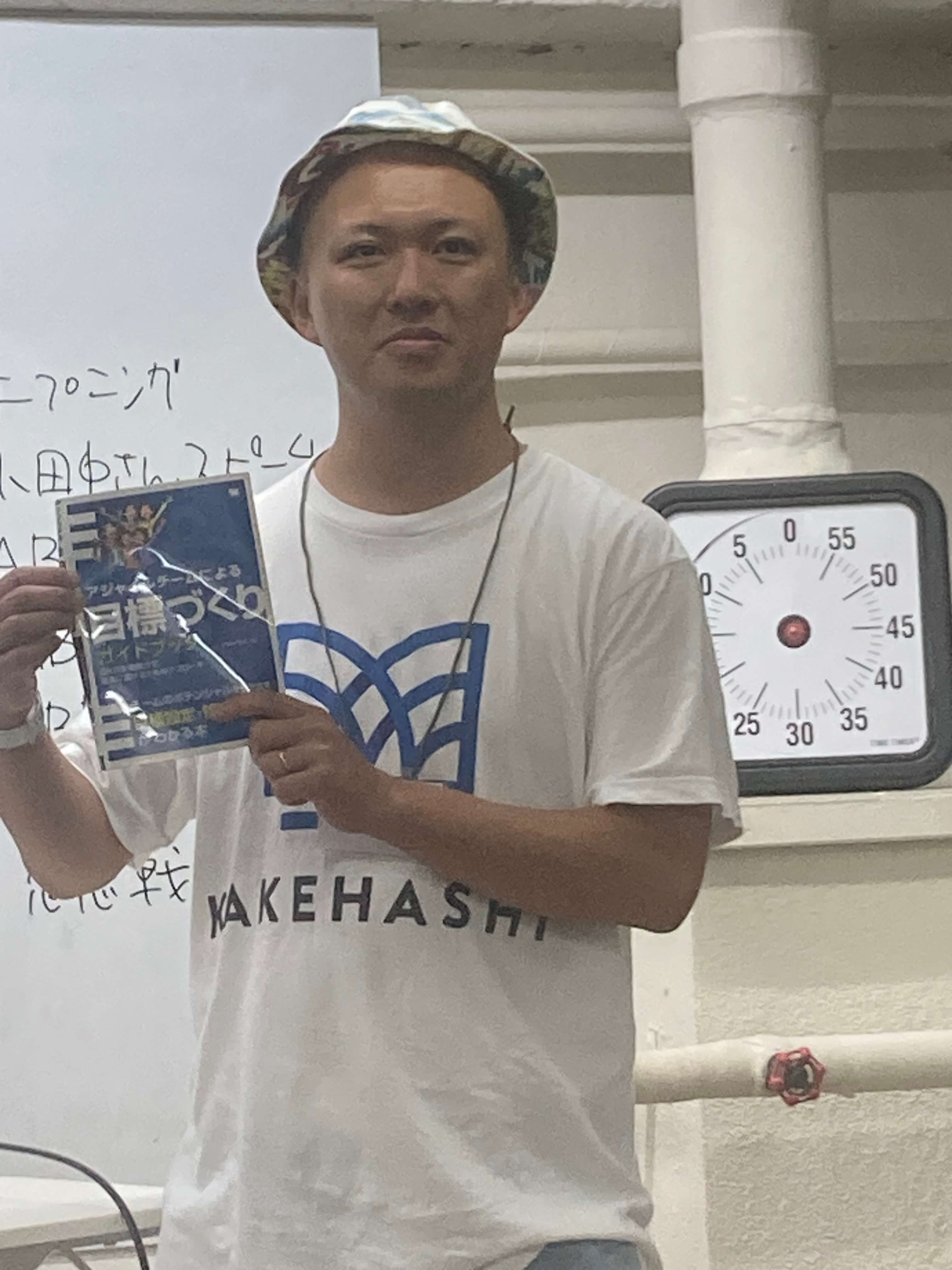未来型読書法 アクティブ・ブック・ダイアローグ®を体験してきました

はじめに
こんにちは。
KINTOテクノロジーズ モバイルアプリ開発グループの中口です。
iOSチームのチームリーダーとしてこれまでにチームビルディングに関する記事を公開しておりますので、ご興味あればぜひご一読ください。
先日、
【たぶん世界最速開催!『アジャイルチームによる目標づくりガイドブック』ABD読書会】
こちらのイベントに参加してきました。
このイベントの参加目的は、主に以下の3点です。
- アクティブ・ブック・ダイアローグ®(以下「ABD」という。)を体験してみたかった。
- イベントで扱う本である「アジャイルチームによる目標づくりガイドブック」に興味があった。
- 著者である「小田中 育生(おだなか いくお)」さんにお会いしてみたかった。
その中でも、ABDという読書法は初めての経験で非常ためになるものでした。この読書法をもっと多くの方に知ってもらいたいと思ったので本記事ではABDに関する内容を中心に紹介させていただきます。
諸注意
本記事で掲載する人物や資料は、全て開催者様及びご本人様より掲載許可をいただいております。
イベントについて
こちらのイベントは2024/07/10(水)に開催されたイベントで、『アジャイルチームによる目標づくりガイドブック』を「刊行前に著者と会えるABD読書会」として開催されました。
募集ページが公開され、その日中に応募枠の15名を突破してしまう人気イベントでして、参加できたことが非常に幸運だったと思います。
イベントのことを紹介してくれた弊社コーポレートITグループのきんちゃんにはとても感謝です!!
本について
本の内容については、実際に読んでもらえればと思いますのでここでは多くは語りませんが、イベントのオープニングでいくおさんが紹介されていた内容を共有させていただきます。
世の中的に目標設定があまり好まれていない傾向があるように感じる。
しかし、みんなが真剣に目標に向き合いそれを達成できるようになれば世界は良くなっていくと思う。
だから、いい目標を作れることはとても大事である。
一方で、目標を作ることも大事だが、それをいかに達成していくかはもっと大事である。
この本では、目標作りに関しては初めの2割程度で、
残りは目標を達成する方法をアジャイルの要素を取り入れつつ紹介する本となっている。
また、目標とセットで語られることの多い人事評価については書いていないが、
8名の方にコラムを書いていただいており、その中で評価の部分も良い感じに補完されているので、
コラムもぜひ読んでほしい!

いくおさんによるオープニングの様子
いくおさんについて
いくおさんとは、これまで面識は無いのですが、下記のLTや記事を拝見して存じておりました。
- 『Keeper of the Seven Keys ~Four Keysとあと3つ~』
- こんなエンジニアリングマネージャだから仕事がしやすいんだなぁと思う10個のこと
- 誇り高き「マネージャー」を全うするために。“理想のEM”小田中氏を支えた珠玉の5冊
開発生産性やエンジニアリングマネージャーに関する考え方、及び読書に対する向き合い方など、とても参考になる部分が多く、ぜひ一度お会いしてお話ししてみたいと思っていました。
しかし当日は簡単な挨拶はさせていただいたものの、しっかりとお話できる時間を作ることができませんでした。
非常に残念でしたが、今後の機会に期待したいと思います。
ABDについて
こちらABDの公式サイトより引用させていただきます。
ABDとは何か?
開発者:竹ノ内 壮太郎さんによる説明
ABDは、読書が苦手な人も、本が大好きな人も、
短時間で読みたい本を読むことができる全く新しい読書手法です。
1冊の本を分担して読んでまとめる、発表・共有化する、気づきを深める対話をするというプロセスを通して、
著者の伝えようとすることを深く理解でき、能動的な気づきや学びが得られます。
またグループでの読書と対話によって、一人一人の能動的な読書体験を掛け合わせることで学びはさらに深まり、
新たな関係性が育まれてくる可能性も広がります。
ABDという、一人一人が内発的動機に基づいた読書を通して、
より良いステップを踏んでいくことを切に願っております。
流れ
- コ・サマライズ
- 本を持ちよるか1冊の本を裁断し、担当パートでわりふり、各自でパートごとに読み、要約を作ります。
- リレー・プレゼン
- リレー形式で各自が要約文をプレゼンします。
- ダイアログ
- 問いを立てて、感想や疑問について話しあい、深めます。
ABDの魅力
- 短時間で読書が可能
- 短時間で読書ができて、著者の想いや内容を深く理解できるので、本を積ん読している方にはピッタリです。
- サマリーが残る
- アクティブ・ブック・ダイアローグ®後にサマリーが残るので、見直して復習したり、本を読んでいない人にも要点を伝えやすくなります。
- 記憶の定着率の高さ
- 発表を意識してインプットしてまとめた後、すぐにアウトプットをして意見交換をするので、深く記憶に定着します。
- 深い気づきと創発
- 多様な人どうし、それぞれの疑問や感想をもって対話することで、深い学びの創発が生まれます。
- 個人の多面的成長
- 集中力、要約力、発表力、コミュニケーション力、対話力など、今の時代に必要なリーダーシップを同時に磨けます。
- 共通言語が生まれる
- 同じメンバーで行うことで、同じレベルの知識を共有できるため、共通言語を作ることができます。
- コミュニティ作り
- 本が1冊あれば仲間との対話や場を作れるので、気軽なコミュニティ作りに最適です。
- 何より楽しい!
- 本を読んで感動したり学んだ熱量をその場ですぐに共有できるので、豊かな学びが生まれ、何より読書が楽しくなります。
個人的には「1. 短時間で読書が可能」、「6. 共通言語が生まれる」、「7. コミュニティ作り」、「8. 何より楽しい!」が価値が高いなと感じました。
当日の様子
本が裁断され15パート分に分かれています。
こんな光景始めみました!笑

裁断された本
-
コ・サマライズ(20分)
各自が担当パートを読み、要約を作成します。
20分で本を読みA4用紙3枚にまとめるのですが、これがなかなか難しかったです。。。
時間に追われすぎていて撮影を忘れてしまいました。 -
リレー・プレゼン(1分30秒/人×15名)
各自が要約したものを、壁に貼り付けます。

みなさんが要約した資料
そして要約したものを1分30秒で発表します。
みなさん、要約もプレゼンもとても素晴らしかったです。
写真は私のプレゼンの様子です。1分30秒というすごく短い時間だったことと緊張で、何を話したか全く覚えていません。。。

私の発表の様子
- ダイアログ(25分)
ここでは、プレゼンの中から3つのパートを参加者でピックアップし、各グループに分かれて深掘りを行いました。
私はその中で「助け合えるチームになろう」のグループに参加させていただきました。

グループによる深掘りの様子
グループ内にはスクラムマスターやエンジニアリングマネージャーをされている方もおり、様々な意見交換をさせていただきました。
その中でも、「好きなこと」は、得意(十八番)/苦手(成長機会)関わらず伸ばしていくべきなので、好きなことに挑戦できるチーム作りをしたいね、という話題が印象的でした。

ABDを通して本から学んだこと
私自身はこれまで、目標管理として「OKR」(Objectives and Key Results)を用いたことがなかったのですが、OKRに関する理解が進みました。
また、目標づくりにおいては、いかに内発的動機によってチームとして目標を立てることが重要かを学びました。
そのためにも、トップダウンによる目標設定を行うのではなく、チーム間で議論を行なった上での目標づくりが鍵となることが印象的でした。
また、重要なのは「目標の達成」であり、「タスクの消化」ではないということも印象に残っております。
そのため「時には優先順位が低いタスクを捨てる勇気が必要である」という考えは、これまでの自分には無い考え方でした。
そして、目標達成のために「時間が無い」ということがあるかと思いますが、それを
- 本当に時間が無い
- 時間をかけて良いか分からない
- 意欲が湧かない
というように分解されているのも初めて聞きました。
「本当に時間が無い」というのはイメージしやすいのですが、「時間をかけて良いか分からない」、「意欲が湧かない」というのは初めて聞きましたが、経験的に納得感がありました。
こちらに関しては、本に解決法なども記載されていたのであたらめて本を読んで復習したいです。
感想
初めてABDを体験いたしましたが、刺激的でとても楽しかったです。
当日参加されていたメンバーが、題材の本に興味がある方ばかりだったので、プレゼンやダイアログにおいても建設的な場であり学びも多かったです。
弊社でもABDを実践してみたいと思ったので、興味があるメンバーを募ってやってみたいな、と考えています。
一方で、下記に挙げるような理由から運用の難易度はかなり高いのではないかと思いました。
- 限られた時間内で進行する必要があるためファシリテーターのスキルが求められる。
- コ・サマライズが難しく、参加者により要約やプレゼンのレベルに差が生じてしまいそう。
- 題材とする本の選定や、メンバー集めが難しそう。
私はこれまで何度か輪読会に参加したことがあるのですが、「長期間の催しから生じる継続の負担」、「(輪読会の形式によりますが)個人の作業負担」など、実際に行うには少々ハードルが高い読書法だと感じていました。
一方でABDは、短時間で一気に終了できるので輪読会で感じていたようなデメリットを解消できるとても良い読書法だと思います。
ただし、短時間が故に本の理解度が下がってしまうという、トレードオフは生じてしまうかと思います。
「題材とする本の選定」や「参加メンバーとの事前協議」をしっかり行なった上でどのような読書法が良いのかは検討の必要があると思いました。
関連記事 | Related Posts

未来型読書法 アクティブ・ブック・ダイアローグ®を体験してきました

Sharing How Great Was Our Group Reading Session 'Learning from GitLab: How to Create the World's Most Advanced Remote Organization'.

Which Agile Milestone Are We at Now?

Introduction to Agile SaaS: The Secrets to Achieving Maximum Results Quickly with Minimal Workload

Revitalizing Retrospectives Through Professional Facilitators
![Cover Image for [Learning Roadside Station Podcast] General Managers MoM Reading Session](/assets/blog/authors/aoi.nakanishi/2024-12-podcast/minutes.jpg)
[Learning Roadside Station Podcast] General Managers MoM Reading Session
We are hiring!
【UI/UXデザイナー】クリエイティブ室/東京・大阪・福岡
クリエイティブGについてKINTOやトヨタが抱えている課題やサービスの状況に応じて、色々なプロジェクトが発生しそれにクリエイティブ力で応えるグループです。所属しているメンバーはそれぞれ異なる技術や経験を持っているので、クリエイティブの側面からサービスの改善案を出し、周りを巻き込みながらプロジェクトを進めています。
【クラウドエンジニア】Cloud Infrastructure G/東京・大阪・福岡
KINTO Tech BlogWantedlyストーリーCloud InfrastructureグループについてAWSを主としたクラウドインフラの設計、構築、運用を主に担当しています。
